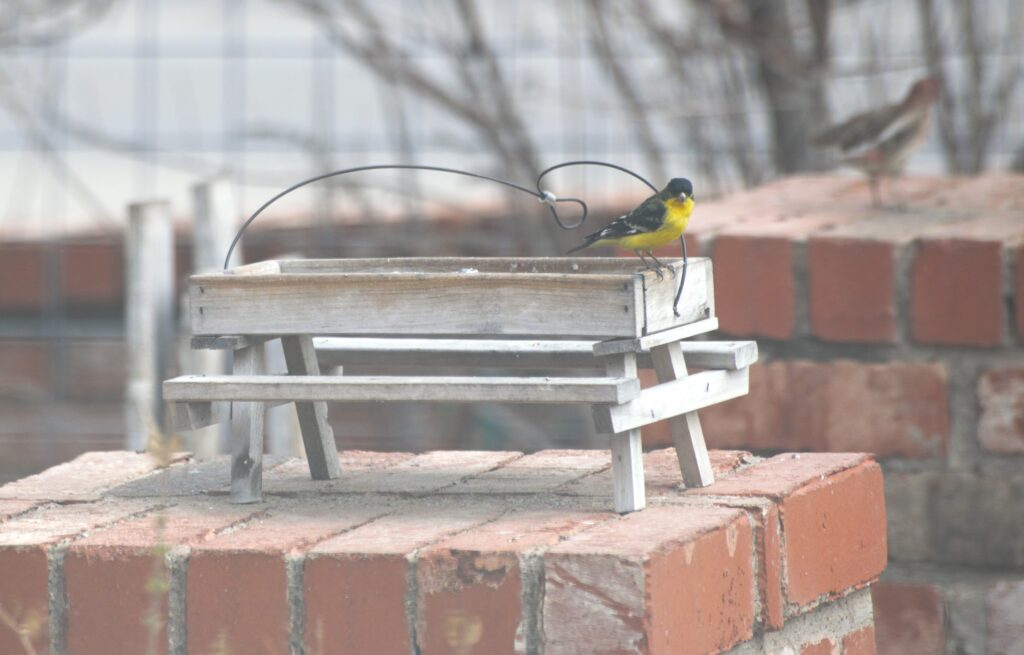By Christopher Collins
The energetic songbird is a comfort in the Big Country cold.
The Big Country’s first freeze of the season came on October 31, 2023, turning vegetable gardens and trick-or-treaters alike into popsicles. My crop of Black Krim tomatoes was among the casualties; in another couple of days I could have filled a bucket with ’em. It was especially frustrating given that the freeze happened so early—11 days earlier than normal, according to the National Weather Service. It felt like a cruel irony when only a week later, on November 8, Abilene scorched its way to a new record-high temperature of 93 degrees (which was not only a record for that day, but for the entire month of November).
By January, winter has blown and blustered its way into the Big Country, for real this time. Which can be mighty unpleasant. But look on the bright side: This is a great time to spot cool new birds—for instance, the lesser goldfinch, a brightly colored songbird that brings cheer to an otherwise dreary season. Last winter, in late February, I managed to attract two or three to a feeder in my garden; they were mixed in with a crowd of American goldfinches and house finches. (Hat tip to Dr. Ian Shelburne for the identification.) A tube feeder filled with nyjer seed was a magnet for all of the finches, and the lesser goldfinches also appeared to be interested in a sunflower suet cake. I hope they come back this year. I’ve got my feeders locked and loaded if they do.
In the section below, I’ll share some general information on the lesser goldfinch, including its appearance, life cycle, and nesting behaviors. If this article piques your interest, consider attempting to attract the lesser goldfinch to your own backyard feeder—with their bold yellow-and-black outfit and acrobatic antics, this bird is a ton of fun to watch.
To get started, here are some basic facts about the lesser goldfinch, or Spinus psaltria. It’s a member of the order Passeriformes, which includes perching birds, and the family Fringillidae, which includes the “true” finches—smallish passerines with thick beaks for crunching seeds. Finches have a widespread distribution and tend to be colorful and fun to watch. The lesser goldfinch is a native bird and is common within its range.
What does it look like? Males have a bright yellow belly and a black back. Look for splotches of white coloration on the wingbars. Females have a dull yellow or olive coloration; their wings are black with white stripes. It is the smallest of the finches, weighing between 8 and 11.5 grams.
Where does it live? The lesser goldfinch can be found all along the Pacific seaboard and into Mexico and Central America, where their range stretches into the Peruvian Andes. This is the only goldfinch that breeds in Texas. You can find them in the hottest and most humid half of the state: from Midland, near the border with New Mexico, to Victoria, halfway up the Gulf Coast. The Big Country appears to sit on the eastern periphery of their native range, making sightings sparser here. The bird’s natural habitat is open woodlands, where it seeks out seed-producing plants. It is readily attracted to feeders, especially seeds of plants from the Asteraceae family (e.g. sunflower, thistle, daisy).
What are its behaviors? Lesser goldfinches can gather in large flocks—numbering several hundred birds—while feeding. They don’t seem to have a problem congregating with other finches. Like mockingbirds, lesser goldfinches sometimes incorporate snippets of songs learned from other birds in their own calls. Researchers have documented the lesser goldfinch mimicking 31 other bird species.
Where does it breed? In warmer climates, the lesser goldfinch doesn’t migrate much before building a nest and raising chicks. Farther north, breeding populations of goldfinches travel to New Mexico, Colorado, Nevada, and Arizona to nest. The male courts the female with a fluttering, chirping display; the female builds the nest and incubates the eggs mostly by herself. She lays 4 to 5 pale blue eggs that hatch after 12 days. Nestlings are fed by both parents.
Why do I like it? And why should you? To me, the lesser goldfinch is a bright spot during the drudgery of winter. Their distinctive black-and-yellow coloration allows them to stand out from the sparse winter foliage. They’re even brighter than the American goldfinches, whose males will still be wearing their (relatively) drab winter coat, only changing into their stunning spring colors after they’ve flown the Big Country coop for points north. Their acrobatic little hops and jumps are fun to watch. I like that they’re the only goldfinch that breeds in Texas—it makes them feel more like a neighbor, or an old friend, coming by to say hello.




